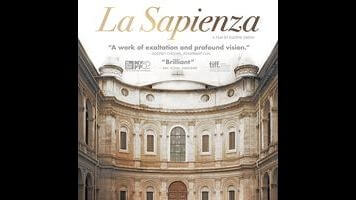Eugène Green’s La Sapienza is art history with warmth and personality

Sometimes toeing the line between sincerity and parody, the eccentric films of Eugène Green inhabit a world of ideas. The French filmmaker—actually an American expat, born Eugene Green, no accent mark—has a unique personal style, which mixes Baroque and medieval art with stripped-down visual values (think Bresson or late Ozu) in a way that can seem post-modern, but isn’t. His best movies are games of make-believe. They invite viewers to play along, as though the characters were traveling actors of an earlier time. His sophomore feature, Le Monde Vivant, for instance, was a medieval fairy tale performed without period costumes or horses, in which a dog played a lion—a vision of a perfect world, where words have authority over reality.
Green’s latest, La Sapienza, doesn’t require the same leap of imagination from the viewer, though the writer-director’s artificial staging and preference for mannered performances guarantee that it never comes across as an attempt at realism. In the film, a childless couple, Alexandre (Dardennes regular Fabrizio Rongione) and Aliénor (Christelle Prot), befriend a teenage brother and sister while sightseeing in Italy. Aliénor stays behind with the bed-ridden Lavinia (Arianna Nastro) to help her improve her French, while Alexandre brings along aspiring architecture student Goffredo (Ludovico Succio) on a trip down to Rome to experience the work of his favorite Baroque architect, Francesco Borromini.
Perhaps for a different filmmaker, these relationships would signal the re-awakening of a dormant parental instinct. But though Alexandre and Goffredo are occasionally mistaken for father and son, the film is first and foremost about the interchange of ideas and knowledge—a theme underscored by Aliénor’s dreamlike encounter with a Chaldean Catholic refugee (Green himself) who worries about not being able to pass on his religion and culture. La Sapienza, Italian for sapience, is both a reference to one of Borromini’s masterpieces and a pet theme of Green’s. Before turning to film in his early 50s, he ran a theater company called Le Théâtre De La Sapience, which specialized in staging work from the Baroque period. His characters are always defined in relation to ideals and idealized worlds, and here the ideal is accumulated personal wisdom—sapience, which Alexandre calls “a beautiful word, but forgotten, like many things.”
Even more importantly, La Sapienza is a chance for Green to offer a tour of his two favorite subjects: the French language and the art of the baroque period. A film of ideas—specifically, ideas about architecture and 17th-century culture—might sound like a dull academic exercise, but Green has too much of a personal take on the subject matter and too much of a sense of humor to make it come across that way. The director’s intentionally non-realistic dialogue and editing, which create music out of isolated line readings and prolonged pauses, can be funny on their own. He also has a penchant for wry gags, like a guide beginning a tour of the Villa Medici by explaining the complicated romantic relationships of all of its current artists-in-residence. (Dryly: “But he doesn’t like girls. He’s always been in love with… Thomas.”)
As in his last feature, The Portuguese Nun, about an actress working on an adaptation of a 17th-century novel, Green doesn’t so much use his characters as mouthpieces as emotionally invest them in art, turning opinions into feelings. When Goffredo compliments Alexandre on his explanation of the difference in style between Borromini and his chief rival, Gian Lorenzo Bernini, Alexandre blurts out that he’s always identified with the latter, despite idolizing the former. In Green’s idiosyncratic universe of stiffly composed figures and architectural curves, sunlit churches and candlelit rooms, there’s no distinction between how people think and how they feel.